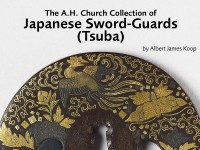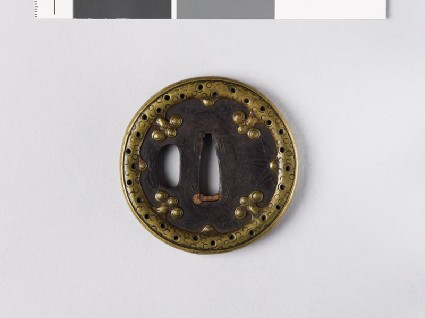The A. H. Church Collection of Japanese Sword-Guards (Tsuba)
An unpublished catalogue of the A. H. Church collection of Japanese sword-guards (tsuba) by Albert James Koop.

Publications online: 1264 objects
Tsuba with maples leaves and brass rim
-
Literature notes
Thick; etched in faint relief with a few maple leaves on each face; brass rim in the three parts, i.e. two broad flanges and the actual almost flat outer rim; the latter is lightly punched with a wavy pattern of circles and dots; the convex flanges, each pierced with a zigzag row of holes and further lightly punched with circles, are inwardly cusped with four trifolate projections alternately with four smaller semicircular ones, and these cusps are similarly punched with circles of various sizes, some concentrically.
Behrens Collection, no.1081. This minute description applies almost eactly to (1) a guard of the same size, formerly in the Hawkshaw Collection (no.45, pl.IV) and later in that of H. L. Joly, showing bamboos instead of maple leaves, and (2) one formerly in the Poncetton Collection (Cat. no.226, pl.XIV), of diam. 2.95", with the iron plain and the flanges uncusped. This latter M. Poncetton attributed to the Jingo School of Higo (Group XIII) and described the flanges as recalling the tentacles of cuttlefish. -
Details
- Associated place
- Date
- 16th - 17th century (1501 - 1700)
- Material and technique
- iron, etched, and taka-zōgan (high relief inlay) in brass; brass inlay punched; tang-hole plugged with soft metal, probably copper
- Dimensions
- 7.2 x 7.3 x 0.8 cm (height x width x depth)
- Material index
-
processed material › metal › iron,processed material › metal › alloy › copper alloy › brass,
- Technique index
- Object type index
-
arms/armour › koshirae › kodogu › tsuba
- No. of items
- 1
- Credit line
- Bequeathed by Sir Arthur H. Church, 1915.
- Accession no.
- EAX.10125
-
Further reading
Koop, Albert James, The A. H. Church Collection of Japanese Sword-Guards (Tsuba), 3 vols (Oxford, Ashmolean Museum, 1929), no. 125
Glossary
tsuba
-
tsuba
Japanese sword guard.
Location
-
- currently in research collection
Objects are sometimes moved to a different location. Our object location data is usually updated on a monthly basis. Contact the Jameel Study Centre if you are planning to visit the museum to see a particular object on display, or would like to arrange an appointment to see an object in our reserve collections.
Publications online
-

The A. H. Church Collection of Japanese Sword-Guards (Tsuba)
Thick; etched in faint relief with a few maple leaves on each face; brass rim in the three parts, i.e. two broad flanges and the actual almost flat outer rim; the latter is lightly punched with a wavy pattern of circles and dots; the convex flanges, each pierced with a zigzag row of holes and further lightly punched with circles, are inwardly cusped with four trifolate projections alternately with four smaller semicircular ones, and these cusps are similarly punched with circles of various sizes, some concentrically.
Behrens Collection, no.1081. This minute description applies almost eactly to (1) a guard of the same size, formerly in the Hawkshaw Collection (no.45, pl.IV) and later in that of H. L. Joly, showing bamboos instead of maple leaves, and (2) one formerly in the Poncetton Collection (Cat. no.226, pl.XIV), of diam. 2.95", with the iron plain and the flanges uncusped. This latter M. Poncetton attributed to the Jingo School of Higo (Group XIII) and described the flanges as recalling the tentacles of cuttlefish.
Notice
Object information may not accurately reflect the actual contents of the original publication, since our online objects contain current information held in our collections database. Click on 'buy this publication' to purchase printed versions of our online publications, where available, or contact the Jameel Study Centre to arrange access to books on our collections that are now out of print.
© 2013 University of Oxford - Ashmolean Museum

